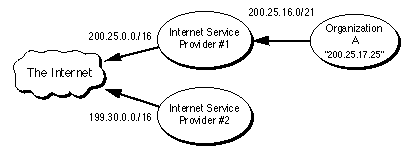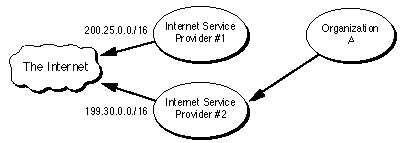




Routing in a Classless Environment
Figure 32 illustrates the routing advertisements for Organization A discussed in the previous CIDR Example.

Figure 32: Routing Advertisements for Organization A
Since all of Organization A's routes are part of ISP #1's address block, the routes to Organization A are implicitly aggregated via ISP #1's aggregated announcement to the Internet. In other words, the eight networks assigned to Organization A are hidden behind a single routing advertisement. Using the longest match forwarding algorithm,Internet routers will route traffic to host 200.25.17.25 to ISP #1, which will in turn route the traffic to Organization A. Now, for whatever reasons, assume that Organization A decides to change its network provider to ISP #2. This is illustrated in Figure 33.

Figure 33: Organization A Changes Network Providers to ISP #2
The "best" thing for the size of the Internet's routing tables would be to have Organization A obtain a block of ISP #2's address space and renumber. This would allow the eight networks assigned to Organization A to be hidden behind the aggregate routing advertisement of ISP #2. Unfortunately, renumbering is a labor-intensive task which could be very difficult, if not impossible, for Organization A.

Figure 34: ISP #2 Injects a More-Specific Route into the Internet
The "best" thing for Organization A is to retain ownership of its address space and
have ISP #2 advertise an "exception" (more specific) route into the Internet.
The exception route allows all traffic for 200.25.0.0/16 to be sent to ISP #1,
with the exception of the traffic to 200.25.16.0/21. This is accomplished by having
ISP #2 advertise,in addition to its own 199.30.0.0/16 block, a route for 200.25.16.0/21.
Please refer to Figure 34. Using the "longest match" forwarding algorithm,
Internet routers will route traffic addressed to host 200.25.17.25 to ISP #2 which
will in turn route the traffic to Organization A. Clearly, the introduction of
a large number of exception routes can reduce the effectiveness of the CIDR deployment
and eventually cause Internet routing tables to begin exploding again!